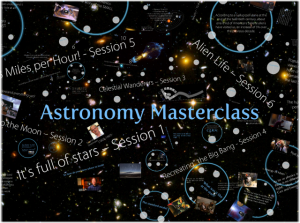Celestial Wanderers: Difference between revisions
(Created page with "{{ResourcePageGroupMenu|TES Teacher of the year 2011 Resources}} {{Rinfo |title=Celestial Wanderers |topic=Astronomy |subject=Science |resourcenumber=SC0021 |age= Secondary, ...") |
No edit summary |
||
| (26 intermediate revisions by 4 users not shown) | |||
| Line 1: | Line 1: | ||
{{ResourcePageGroupMenu|TES | {{ResourcePageGroupMenu|TES Teaching Resource of the Year - 2011}} | ||
{{Rinfo | {{Rinfo | ||
|type= Lesson idea | |||
|attribution={{Andrew Jackson}} | |||
|title=Celestial Wanderers | |title=Celestial Wanderers | ||
|tagline=Why would we fly to another planet to study its rocks? | |||
|image=Astronomymasterclasstitlepage.png | |||
|topic=Astronomy | |topic=Astronomy | ||
|final=yes | |||
|subject=Science | |subject=Science | ||
|resourcenumber=SC0021 | |resourcenumber=SC0021 | ||
|age= Secondary | |age= KS4, Secondary | ||
|content= | |content=A look at the geology of the solar system and the fleet of robotic explorers that have provided much of the information we have. This is session 3 of a series of 6 entitled [[Astronomy Master Class]]. | ||
|strategy= | |strategy= | ||
|Learning Objectives= | |||
* Appreciating the vast differences between the bodies in the solar system and some of the reasons for these differences.<br /> | |||
* Understanding why robots are used to explore these distant worlds.<br /> | |||
* Understanding how asteroid cratering can be used to date surfaces on rocky bodies and how it leads to evidence of water flows on Mars and Europa. | |||
|additional resources= | |additional resources= | ||
|useful information= | |useful information= | ||
|related resources=[[Astronomy | |related resources= | ||
* [[88 Miles per hour]] | |||
* [[Astronomy Master Class]] | |||
* [[It's full of stars]] | |||
* [[From Earth to Moon]] | |||
* [[Recreating the Big Bang]] | |||
|other= | |other= | ||
|format= | |format=An 30 minute narrated screen cast which is part of the full, six hour 'Astronomy Master Class'. Also supplied as a Prezi and a Acrobat file should you wish to do the presentation yourself. The [[Astronomy Master Class]] overview tells how the resource was used. | ||
|resources= | |resources= | ||
* [[Celestial Wanderers/Teacher's Notes|Teacher's Notes]] | |||
* Narrated video - 30 mins: http://www.youtube.com/watch?v=AVBU4SrVNvU&feature=relmfu <br /> | |||
* Astronomy Masterclass - Prezi Slide presentation: http://prezi.com/2hk390sfkqjh/the-astronomy-masterclass/ <br /> | |||
* Acrobat PDF document - for session 3, use pages 69-97 of Astronomy masterclass.pdf: https://www.box.com/shared/aqnk3lvr09 (241Mb) | |||
* TES Resources link: http://www.tes.co.uk/teaching-resource/The-Astronomy-Masterclass-6070303/ This also includes links to other YouTube videos. | |||
Title page graphic only: | |||
[[File:astronomymasterclasstitlepage.png|300px]] | |||
}} | |||
[[Category:Secondary]] [[Category:Science]] | |||
Latest revision as of 12:03, 24 January 2015
Lesson idea. A look at the geology of the solar system and the fleet of robotic explorers that have provided much of the information we have. This is session 3 of a series of 6 entitled Astronomy Master Class.
Teaching approach. Drawing on a rich range of sources, this presentation allows the teacher to introduce planetary geology(topic), something not normally studied until degree level. It uses the narrative(ta) of the Voyager Probes journey to illustrate the vastness of the solar system(topic) and also the challenges of designing a spacecraft to travel that far. It ends with a discussion of the history(topic) of Mars, and how the differences between it and the Earth resulted in Mars loosing its water and atmosphere whereas we have kept ours. (edit)
| Resource details | |
| Title | Celestial Wanderers |
| Topic | [[Topics/Geology|Geology]], [[Topics/Solar system|Solar system]], [[Topics/History|History]], [[Topics/Astronomy|Astronomy]] |
| Teaching approach | [[Teaching Approaches/Narrative|Narrative]] |
| Learning Objectives |
|
| Format / structure | An 30 minute narrated screen cast which is part of the full, six hour 'Astronomy Master Class'. Also supplied as a Prezi and a Acrobat file should you wish to do the presentation yourself. The Astronomy Master Class overview tells how the resource was used. |
| Subject | [[Resources/Science|Science]] |
| Age of students / grade | [[Resources/Secondary|Secondary]], [[Resources/KS4|KS4]]
|
| Related ORBIT Wiki Resources | |
| Files and resources to view and download |
Title page graphic only:
|

